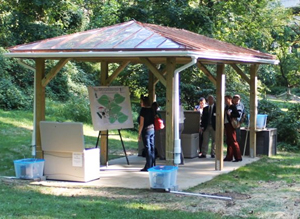September 19, 2012
FOR IMMEDIATE RELEASE
New Study Seeks Definitive Evidence that Copper Roof Runoff Can be Controlled
NEW YORK-Researchers this week launched a new study to determine the environmental impact of copper roof runoff in urban areas.
The researchers' goals are to collect and process definitive data on the management of copper from roof runoff and the safety of copper roofing materials as they're used in urban areas. The study, Attentuation of the Potential Impacts of Copper Roof Runoff by Stormwater Best Management Practices, will determine the effectiveness of rain gardens (bioretention cells) and grass channels (biofiltration swales) in preventing copper from entering surface waters.

Researchers will assess whether commonly used stormwater treatment systems successfully reduce the level of the elements in runoff water from copper roofs, protecting the environment from potential risk," says Joe Gorsuch, Copper Development Association (CDA) health, environment and sustainable development manager. "We look forward to the results of the study."
Copper roofs have recently come under scrutiny as a potential source of copper in local waterways. Some communities concerned about stormwater runoff have enacted regulations to monitor for potential contamination. Both the CDA and the International Copper Association (ICA) support the study as a way to address these concerns using scientific evidence to determine the real impact of copper in the environment.
"We're committed to ensure the safe and sustainable use of copper. The study will provide risk assessments that are based on scientifically accurate data," says Gorsuch.
Scientists at Towson University, located in Towson, Md., near Baltimore, launched the two-year study Sept. 13 in collaboration with Mutch Associates, LLC, an environmental science and engineering company. As part of the study, the university built a copper-roofed picnic shelter to assess both the amount and quality of stormwater runoff generated by the structure. In addition, the study will:
- Provide a better understanding of the amount of copper released into stormwater runoff from copper roofs/cladding over time.
- Use scientific evidence to determine the effectiveness of best management practices (BMPs) aimed at reducing copper and other contaminants in runoff.
"We are evaluating stormwater management practices for their ability to prevent offsite transport of copper and allow for the sustainable use of copper roofing materials in urban environments," says Ryan Casey, a Towson University chemistry professor and the study's principal investigator.
This study will address questions raised by regulators and legislators, who have expressed concerns about the allowable concentrations of metals and other contaminants in stormwater runoff.
"Building owners and architects choose copper for durable, efficient and beautiful buildings," says Andy Kireta, Jr., the CDA's vice president, building construction. "In areas where there are stringent regulations based on runoff concerns, this study should confirm that they can use low-cost, easily maintained mechanisms for controlling that runoff."
Study results will be released next fall, after a year's worth of data has been collected.
About the Copper Alliance™
The Copper Alliance is a group of global copper associations led by the International Copper Association, Ltd. Its mission is to defend and grow markets for copper, based on its superior technical performance and its contribution to a higher quality of life worldwide. The Copper Development Association is also a member of the Copper Alliance, representing North America.
About the International Copper Association, Ltd.
The International Copper Association, Ltd., increases awareness and the usage of copper by communicating the unique attributes that make this sustainable element an essential contributor to the formation of life, to advances in science and technology, and to a higher standard of living throughout the world. The ICA's 43 members represent a majority of the world's refined copper output and are among the largest copper producers, fabricators and wire and cable companies.
###
